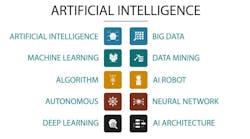This article originally appeared in Access Control Trends & Technology, an annual bonus publication to Security Business magazine and Security Technology Executive magazine.
AI is improving industries virtually across the board — from helping to better detect lung and breast cancer to extend the life of machines through predictive maintenance. By pattern matching at scale and automating mundane tasks, AI is enabling experts to focus on what they do best.
AI has already been cemented into most companies’ cybersecurity posture. Cybersecurity professionals are using AI to detect and easily solve malicious network behaviors quickly, with 83% of organizations stating that they wouldn’t be able to deal with cyberattacks without AI.
What About AI for Physical Security?
This begs the question: why is physical security lagging so far behind cybersecurity in the adoption of AI? For physical security professionals, AI has the ability to transform how they respond to threats, moving from a largely reactive posture, in which teams respond to threats after they happen, to a proactive posture, in which risks are automatically detected. This enables security professionals to intervene before an incident escalates or even occurs. For the business, proactive physical security can reduce operation costs, improve employee retention and, most importantly, result in better protection of people and assets.
There are certain physical behaviors that indicate a perimeter security threat, like someone jumping a fence, spoofing a badge at a secure entrance, forcing a door open or tailgating. Each action indicates a pre-incident security threat that could negatively impact people or assets if left unchecked. Leveraging AI, we have an opportunity to identify these threats early, rather than waiting for the security incident to happen.
Incidents tend to follow predictable patterns of smaller instances of threats, which have signatures of physical human movement. Until quite recently, human effort was required to pattern match these behaviors. Someone would need to see the threat behavior happen, either in-person or via surveillance feed. Or an alert might be raised by a physical access control system (PACS), which then requires a human to verify the legitimacy of the alert. AI can solve this very time-consuming task, enabling security teams to focus on responding to threats before they escalate.
As an example, let's look at a relatively large corporate campus with 300 security cameras and 500 doors connected to PACS. Because PACS are relatively simple and constrained to tracking hardware events such as badge reads, they are unable to provide the context security teams need to accurately detect threat signatures. A PACS alert indicating a door being forced open by an intruder looks the same as a strong gust of wind or a faulty maglock.
Let AI Do the Work
PACS deployed across large-scale corporate campuses generate thousands of alerts a day, with more than 90% reporting as false alerts. These false alarms could be triggered by a door held open for just a moment longer than expected or by an invalid badge alert caused by a faulty read. As a result, a human must visually confirm each alert – resulting in a huge manual lift.
Many companies have policies that require security teams to verify the validity of each alarm. According to customer interviews, dispositioning false alerts for a relatively large corporate campus equates to 8,000+ hours each year. That is the equivalent of four full-time employees. At these volumes, security teams often succumb to “alert fatigue,” which leads to a slower response to alerts or alerts being missed altogether. This increases the likelihood that a legitimate security threat goes undetected.
The simplicity of false alarm patterns makes PACS a prime candidate for AI-powered automation. Using AI to tap into existing PACS and camera surveillance systems enables these types of events to be automatically dispositioned. The combination of connectivity to pre-existing hardware systems, AI and computer vision is a solution recently introduced to the market called computer vision intelligence.
It combines the visual verification of computer vision with the pattern matching capabilities of AI to monitor existing surveillance video feeds instantly and accurately detect threat behaviors at any scale of campus. Computer vision intelligence triages incoming alerts on behalf of security teams, significantly reducing the volume of alerts and providing more time for security personnel to act.
Computer vision intelligence effectively becomes the software brain for the signals that hardware-centric security tools create. If cameras are the eyes and PACS are the ears, computer vision intelligence is the brain that turns those signals into actionable information.
Early adopters of computer vision intelligence, such as VMWare, have been able to reduce alarm volumes by 93% and reduce hard-to-detect threat behaviors like tailgating by more than 99%. Similarly, NorCal Cannabis is able to prioritize alerts based on the requirements of a wide variety of locations — from growing facilities to retail stores — by leveraging this technology. For example, a door propped open at a warehouse during the day is much less concerning than if a door is propped open in the middle of the night. Computer vision intelligence is able to understand the context and treat each of those situations differently. When connected to a triage system, it can also initiate the proper escalation path, ensuring fast and effective response and dispatching.
AI Drives Innovation
The industry is just now catching on to the value of integrating security systems with layers of intelligence, creating a whole new market of startups. In fact, Grandview Research predicts US Enterprises will spend $171 billion per year by 2027 to secure people, places and physical assets. The industry growth not only reflects an increasing demand for innovation in physical security but also shows broader promise that with additional resources this technology will be able to deliver significant advancements in the coming years.
PACS and security cameras create a foundation for enterprise access control. Now, with innovations in computer vision and AI those tools can be augmented to create an efficient and actionable approach to perimeter security. Security teams can focus on responding to and preventing security incidents rather than monitoring surveillance feeds and dispositioning false alerts. The existing investments companies have made into cameras and PACS become even more effective as physical security enters a new era of AI. In tandem, security professionals are empowered to better protect people and assets.








